
|
Welcome to the
PERSONAL PAGEof Rob Orland, Coventry, England. |

|
Scouts
From the age of eight, when I joined the 49th Coventry Cubs, scouting was a huge part of my life, passing through to Scouts, Venture Scouts, Assistant and Scout Leader. Much more about the this Scout Group can be found on the 49th Scouts pages.
Band Life
Still staying within the theme of family, in the summer of 1983 two cousins of mine, Graham and Nick Martin, who both played guitar, joined together with me on the drums to form a band.
Joined by Steve and Eric, as singer and bassist respectively, and under the name of "Shylo", we mostly did cover versions of 60s and early 70s songs including The Beatles (who else?) and the Stones. Occasionally we attempted something a little heavier, and if you click on the appropriate link you can hear a snatch of Deep Purple's Smoke on the Water from a rehearsal at the Bulls Head Pub in March 1985.
Not all our music was unoriginal, however. Another Man was the first attempt by myself to write a song for the band. The lyrics were co-written with the singer, Steve.
After two years together, the members of that first band went our separate ways, but Nick and I ended up being invited to join a newly formed covers band in the autumn of 1985, so for six months I played drums with Tryx, led by experienced guitarist & singer Mick, and including the excellent John Oswin on rhythm guitar with Nick switching to bass. After leaving them in April 1986 the band underwent many changes, ending up as a duo - Mick being joined by his girlfriend Marie on vocals.
Here is an excerpt from an early rehearsal (Jan. 1986) in the Radford Social Club.... Knock on Wood .
After giving up band life, I contented myself in the 1990s with composing music at home using the excellent Cubase programme on the PC.
Here are some short excerpts of instrumental pieces (I can't sing!) that I put together many years ago....
Home Recording
It was my enjoyment of trying to write music that eventually led me, inadvertently, to "getting into" computers. To the many people who knew that I'd tinkered around with electronics since school days, it must've seemed rather surprising that I'd always shunned anything resembling a computer. I couldn't explain it myself but I showed no interest whatsoever in owning a PC, almost to the point of actually being frightened to use one!
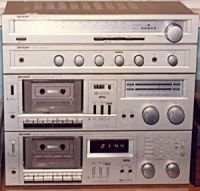
However, after struggling to record music by layering or 'bouncing' tracks, first of all using two stereo cassette decks (see my old 1981 hi-fi on the left!) and later with a Yamaha 4-track recorder (bottom right-hand-side in the photo below), it was suggested to me that I ought to try an Atari computer and some software called "Cubase". "What?" I said.... "Use a computer....? Me....?" Well, it might be a slight exaggeration to say that it changed my life, but it certainly had a profound affect on what I've done in my spare time ever since.
Going back to the early recording processes, there were several disadvantages to using cassette based recorders. One obvious problem is noise. By the time you've copied the first recording of (for example) the drum track to the second tape track, while overdubbing a guitar piece, and then repeated that a third and fourth time, etc., adding other parts, the noise that was just slight 'background noise' becomes somewhat intrusive and the first tracks that were recorded start to disappear under the hiss.
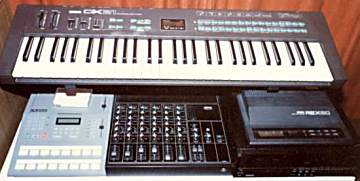
Another problem is that, unless you are a polished player, it is difficult to play a recording from start to finish in one take. This has severe limitations for me, as I can barely go a few bars between mistakes! For these reasons, using the computer for recording was an absolute blessing. When recording using a MIDI sequencer, not only can you record just short chunks at a time and then join them together, but you can also go back into the programme after a "take" and correct any wrong notes that you made, without having to play the same part all the way through a hundred times, hoping that just once you get the whole piece right! Despite this, I did occasionally achieve a complete analogue recording by overdubbing a few single "takes" together into a piece of music. Apart from pre-programming the drum machine, the following instrumental consists of live playing of bass, lead & rhythm guitars, with the DX-21 synthesiser acting as an organ. This piece, Rhythm and Blue-ish was made using the set-up described below....
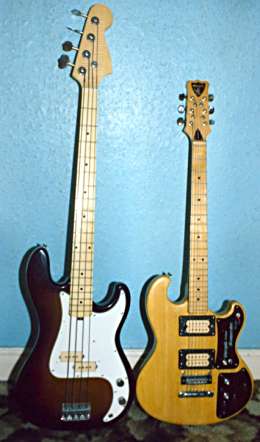
Pictured above is my mid-1980s mini recording studio. Impressed? (Thought not!) The keyboard is a Yamaha DX-21, a very popular choice among amateur bands at the time. It was a baby brother to the DX-7 which was seen being used by keyboard players on Top of the Pops almost every week. The DX-21 came without touch sensitivity though, and had fewer sound textures, although with the ability to play two 'voices' at once or split the keyboard into two sounds it was still a very versatile instrument.
The drum machine on the left of the photo is an Alesis HR-16 which was top notch then with its CD quality sampled drum sounds and touch sensitivity. It could be programmed with a drum sequence or played in "real-time" and overdubbed until you sounded like Buddy Rich. (Who? I hear you asking!) Sitting on top of the 4-track cassette deck is the old Yamaha REX-50 sound effects box. It provided reverb, chorus, distortion and echo to add a little sparkle to an otherwise dull recording. The 6-track stereo mixer in the middle is also Yamaha and pulls all the noises together.
The bass guitar in the photo was only a cheap Fender copy, but the six-string was a much more desirable instrument which served me well for nineteen years. It's a Shergold Custom Masquerader (hand-crafted in London in the late 1970s). That guitar began life a nice burgundy colour, but had been rather battered, so it wasn't long before I stripped all the lacquer and paint off and left it natural. I also chiselled out beneath the scratch-plate and built into it a fuzz circuit. It has a very versatile switch arrangement and the twin DiMarzio humbuckers (not original Shergold spec.) can be set in fifteen different configurations, including single-coil, full-humbucker, or "out-of-phase" settings for each pickup independently. When, in 2002, it came to replacing it, my opinion at the time was that the only upwards step from the Shergold was to get a Les Paul, a guitar I'd always loved the look of. I couldn't afford the mortgage on a genuine Gibson model, but by all accounts the early Tokai copies were made to such exacting standards that virtuosos such as Robert Fripp (King Crimson) were reportedly unable to tell them apart from a genuine Gibson. Thus, it is was a black Japanese made Tokai Love Rock (their Les Paul equivalent model) that I bought next, backed ably by an 80 Watt Valvestate Marshall combo, which sounds great when over-driven for a natural sounding valve distortion.
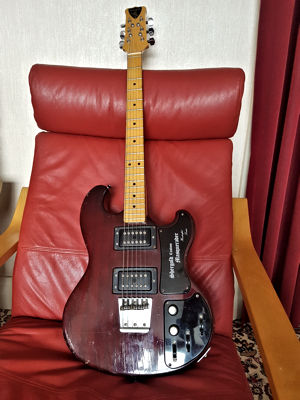
The problem I had with my particular Tokai, however, was that it had a relatively wide neck, more akin to a classical guitar - and I have relatively small hands - therefore it wasn't physically a match made in heaven for me, despite it's lovely growling tones. It was soon to be replaced by a well made Korean Fender 'Squier' Strat. Not a normal one with three single pickups, however. No, I couldn't put up with such a thin sound after the Les Paul noise. In December 2003 I ended up on eBay finding a 'Double Fat Strat', adorned with a pair of twin humbuckers like the Les Paul and Shergold before it. And it did sound fat too. Not quite the same growl as the Tokai, but a shinier, more biting, sound - very nice in its own way.
In 2018 I finally realised that only one guitar has ever both sounded right and fitted in my hands perfectly - and that was the old Shergold. In July that year I found one on eBay (pictured on the right) - the same deep burgundy colour as my first electric guitar had been.

The Premier drum-kit pictured here is long gone (it provided the deposit on my old Ford Orion in 1988) but certainly not forgotten (at least, not by the neighbours!). With two bass drums and eight tom-toms, it was capable of a very big sound, even without amplification.
The latter instruments conclude the analogue elements to the line-up. Despite having these, my natural laziness meant that all the instrumental pieces in the section above (with the exception of "Rhythm and Blue-ish") were only recorded using MIDI voices in the PC's sound card. It was more than just a normal sound card though. It was a Yamaha SW1000XG containing over 1,200 'voices' with a 6-bus digital sound processor which could apply up to six simultaneous sound effects to its internal sounds or to "live" instruments & vocals. It really was a self contained recording studio, but due to lack of support by more recent computer operating systems I can no longer use that sound card.... I miss it!
Going live again
In 2017 our son, Steve, was encouraged by a friend to go along with him to an "open mic" (traditionally known as a "free & easy") at the nearby Devonshire Arms pub, and have a go at playing guitar in front of a small audience. Until then Steve had only played live at school concerts and, like so many guitarists around the world, played mainly for his own amusement in the bedroom. He went down well and gained confidence, so began going along every couple of weeks.
After about two months, in August, he convinced me that I ought to accompany him and ask for a go on the drums. I'd not played with other musicians for 31 years, but I couldn't resist the opportunity of trying again. So, I went along and got introduced to the host band, Flat Badger, who were extremely welcoming and friendly. They let me play two numbers - Johnny B Goode and Sunshine of Your Love. As I first sat down behind their drum-kit I felt so nervous, but by the time we'd played the two songs I felt completely at home again after all those years, and knew I had to continue. We still join them virtually every week, so, many sincere thanks to Josh, Eddie & Simon for putting live music back into our lives again!
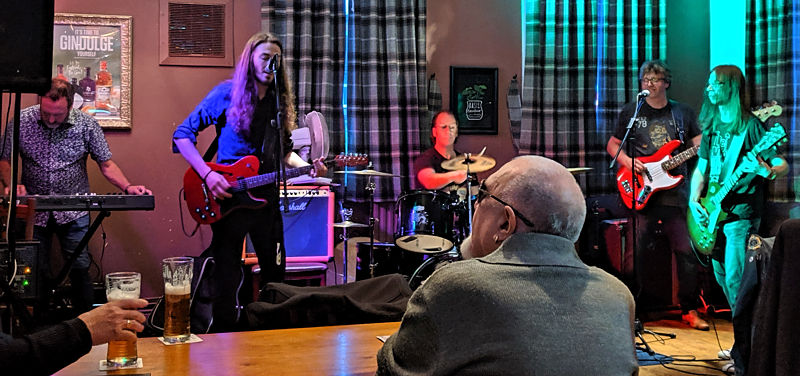
Open-mic night at the Devonshire Arms, June 2019.
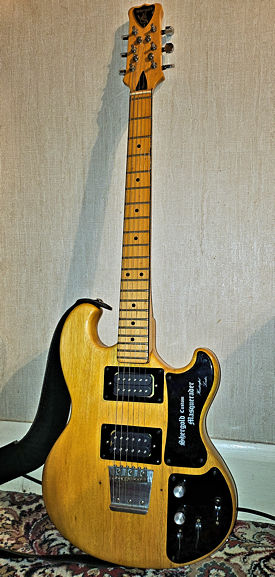
Time to modify the guitar.... again!
The Shergold I bought in 2018 was definitely the guitar I wanted to keep.... but it really was a scruffy thing! I'd not intended to modify it at first, but I decided it would look much nicer in natural wood again. Not only that, but I felt in the mood to go the whole hog and sculpt it with a "belly cut" and "arm cut", too (in similar fashion to a Stratocaster), to make it more pleasant to hold and play. Shergolds have a similar square-edged body style to a Telecaster, and can feel "blocky" to some people.
So, out came the sander, etc., and a week or so later it looked more like this, on the right:
However, something was still niggling me sound-wise. My first Shergold, back in the 1980s, had a sharper sound, and certain pickup combinations - particularly a mix of humbucker with out-of-phase coils - could give a lovely twangy sound, which this latest model lacked. I have our Steve to thank for the answer to this conundrum: He noticed from the early photos that the cream coloured pickups were old DiMarzio Super-Distortions, and replacing my stock Shergold pickups with these should solve the problem.
So I did! They're black this time (as you can see in the photograph), and I had to fashion my own pair of pickup rings from perspex to make them fit, as there is quite a substantial size difference. But it was well worth it, and it's now sounding fantastic - especially when in the hands of someone who can actually play the thing!
This is your first visit to my website today, thank you!
290,769
